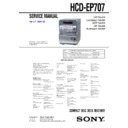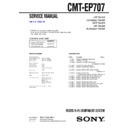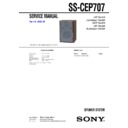Read Sony CMT-EP707 / HCD-EP707 Service Manual online
SERVICE MANUAL
COMPACT DISC DECK RECEIVER
US Model
Canadian Model
AEP Model
UK Model
Australian Model
HCD-EP707
Ver 1.7 2004.02
HCD-EP707 is the amplifier, CD
player, tape deck and tuner section
in CMT-EP707.
player, tape deck and tuner section
in CMT-EP707.
SPECIFICATIONS
CD
Model Name Using Similar Mechanism
NEW
Section
CD Mechanism Type
CMCJ-0132
TAPE
Model Name Using Similar Mechanism
HCD-EP505
Section
Tape Transport Mechanism Type
CRL4349
9-874-043-08
Sony Corporation
2004B05-1
Home Audio Company
C
2004.02
Published by Sony Engineering Corporation
CD player section
System
Compact disc and digital
audio system
audio system
Laser
Semiconductor laser
(
(
λ=780 nm)
Emission duration:
continuous
continuous
Frequency response
20 Hz - 20 kHz (
±0.5 dB)
OPTICAL DIGITAL OUT
(Square optical connector jack, rear panel)
Wavelength
(Square optical connector jack, rear panel)
Wavelength
660 nm
Tape player section
Recording system
4-track 2-channel stereo
Frequency response
50 - 13 000 Hz (
±3 dB),
using Sony TYPE I
cassette
cassette
Tuner section
FM stereo, FM/AM superheterodyne tuner
FM tuner section
Tuning range 87.5 - 108.0 MHz
Antenna
Antenna
FM lead antenna
Antenna terminal (Except for European model)
75
Ω coaxial
Intermediate frequency
10.7 MHz
AM tuner section
Tuning range
Pan-American model:
Pan-American model:
530 - 1 710 kHz
(with the interval set at
10 kHz)
531 - 1 710 kHz
(with the interval set at
9 kHz)
(with the interval set at
10 kHz)
531 - 1 710 kHz
(with the interval set at
9 kHz)
European model:
531 -1 602 kHz
(with the interval set at
9 kHz)
(with the interval set at
9 kHz)
AUDIO POWER SPECIFICATIONS:
(U.S.A. model only)
(U.S.A. model only)
POWER OUTPUT AND TOTAL
HARMONIC DISTORTION:
HARMONIC DISTORTION:
with 4
Ω loads both channels driven, from 120
- 10,000 Hz; rates 15 W per channel minimum
RMS power, with no more than 10% total
harmonic distortion from 250 mW to rated
output.
RMS power, with no more than 10% total
harmonic distortion from 250 mW to rated
output.
Amplifier section
Canadian model:
Canadian model:
Continuous RMS power output (reference)
15 + 15 W
(4
(4
Ω at 1 kHz, 10% THD)
European model:
DIN power output (rated) 12 + 12 W
(4
Ω at 1 kHz, DIN)
Continuous RMS power output (reference)
15 + 15 W
(4
(4
Ω at 1 kHz, 10% THD)
Music power output (reference)
38 + 38 W
Other model:
The following measured at AC 230 V or AC 120 V,
50/60 Hz
DIN power output (rated) 12 + 12 W
50/60 Hz
DIN power output (rated) 12 + 12 W
(4
Ω at 1 kHz, DIN)
Continuous RMS power output (reference)
15 + 15 W
(4
(4
Ω at 1 kHz, 10% THD)
Inputs
MD IN (phono jacks):
MD IN (phono jacks):
voltage 450 mV,
impedance 47 kilohms
impedance 47 kilohms
Outputs
PHONES:
PHONES:
Accepts headphones of
(stereo mini jack)
8
Ω or more
SPEAKER:
Accepts impedance of 8 to
16
16
Ω
General
Power requirements
North American model :
North American model :
120 V AC, 60 Hz
Other models:
230 V AC, 50/60 Hz
Power consumption
European model:
European model:
38 W
0.5 W (in the standby
mode)
0.5 W (in the standby
mode)
Other models:
38 W
Dimensions (w/h/d):
Approx. 180
× 246 × 335 mm
Mass:
Approx. 5.0 kg
Supplied accessories:
AM loop antenna (1)
Remote Commander (1)
Batteries (2)
FM lead antenna (1)
(Except for European
model)
Remote Commander (1)
Batteries (2)
FM lead antenna (1)
(Except for European
model)
Design and specifications are subject to change
without notice.
without notice.
Other models:
531 - 1 602 kHz
(with the interval set at
9 kHz)
530 - 1 710 kHz
(with the interval set at
10 kHz)
(with the interval set at
9 kHz)
530 - 1 710 kHz
(with the interval set at
10 kHz)
Antenna
AM loop antenna
Intermediate frequency
450 kHz
2
HCD-EP707
Notes on chip component replacement
• Never reuse a disconnected chip component.
• Notice that the minus side of a tantalum capacitor may be dam-
• Notice that the minus side of a tantalum capacitor may be dam-
aged by heat.
Flexible Circuit Board Repairing
• Keep the temperature of the soldering iron around 270 ˚C dur-
ing repairing.
• Do not touch the soldering iron on the same conductor of the
circuit board (within 3 times).
• Be careful not to apply force on the conductor when soldering
or unsoldering.
This appliance is classified as a CLASS 1 LASER product.
The CLASS 1 LASER PRODUCT MARKING is located on
the bottom.
The CLASS 1 LASER PRODUCT MARKING is located on
the bottom.
CAUTION
Use of controls or adjustments or performance of procedures
other than those specified herein may result in hazardous ra-
diation exposure.
other than those specified herein may result in hazardous ra-
diation exposure.
SAFETY-RELATED COMPONENT WARNING!!
COMPONENTS IDENTIFIED BY MARK
0
OR DOTTED
LINE WITH MARK
0
ON THE SCHEMATIC DIAGRAMS
AND IN THE PARTS LIST ARE CRITICAL TO SAFE
OPERATION. REPLACE THESE COMPONENTS WITH
SONY PARTS WHOSE PART NUMBERS APPEAR AS
SHOWN IN THIS MANUAL OR IN SUPPLEMENTS PUB-
LISHED BY SONY.
OPERATION. REPLACE THESE COMPONENTS WITH
SONY PARTS WHOSE PART NUMBERS APPEAR AS
SHOWN IN THIS MANUAL OR IN SUPPLEMENTS PUB-
LISHED BY SONY.
Fig. A.
Using an AC voltmeter to check AC leakage.
1.5 k
Ω
0.15
µ
F
AC
voltmeter
(0.75 V)
voltmeter
(0.75 V)
To Exposed Metal
Parts on Set
Parts on Set
Earth Ground
ATTENTION AU COMPOSANT AYANT RAPPORT
À LA SÉCURITÉ!
LES COMPOSANTS IDENTIFIÉS PAR UNE MARQUE
0
SUR LES DIAGRAMMES SCHÉMATIQUES ET LA LISTE
DES PIÈCES SONT CRITIQUES POUR LA SÉCURITÉ
DE FONCTIONNEMENT. NE REMPLACER CES COM-
POSANTS QUE PAR DES PIÈCES SONY DONT LES
NUMÉROS SONT DONNÉS DANS CE MANUEL OU
DANS LES SUPPLÉMENTS PUBLIÉS PAR SONY.
DES PIÈCES SONT CRITIQUES POUR LA SÉCURITÉ
DE FONCTIONNEMENT. NE REMPLACER CES COM-
POSANTS QUE PAR DES PIÈCES SONY DONT LES
NUMÉROS SONT DONNÉS DANS CE MANUEL OU
DANS LES SUPPLÉMENTS PUBLIÉS PAR SONY.
SAFETY CHECK-OUT
After correcting the original service problem, perform the follow-
ing safety check before releasing the set to the customer:
Check the antenna terminals, metal trim, “metallized” knobs,
screws, and all other exposed metal parts for AC leakage.
Check leakage as described below.
ing safety check before releasing the set to the customer:
Check the antenna terminals, metal trim, “metallized” knobs,
screws, and all other exposed metal parts for AC leakage.
Check leakage as described below.
LEAKAGE TEST
The AC leakage from any exposed metal part to earth ground and
from all exposed metal parts to any exposed metal part having a
return to chassis, must not exceed 0.5 mA (500 microamperes.).
Leakage current can be measured by any one of three methods.
1. A commercial leakage tester, such as the Simpson 229 or RCA
from all exposed metal parts to any exposed metal part having a
return to chassis, must not exceed 0.5 mA (500 microamperes.).
Leakage current can be measured by any one of three methods.
1. A commercial leakage tester, such as the Simpson 229 or RCA
WT-540A. Follow the manufacturers’ instructions to use these
instruments.
instruments.
2. A battery-operated AC milliammeter. The Data Precision 245
digital multimeter is suitable for this job.
3. Measuring the voltage drop across a resistor by means of a
VOM or battery-operated AC voltmeter. The “limit” indica-
tion is 0.75 V, so analog meters must have an accurate low-
voltage scale. The Simpson 250 and Sanwa SH-63Trd are ex-
amples of a passive VOM that is suitable. Nearly all battery
operated digital multimeters that have a 2 V AC range are suit-
able. (See Fig. A)
tion is 0.75 V, so analog meters must have an accurate low-
voltage scale. The Simpson 250 and Sanwa SH-63Trd are ex-
amples of a passive VOM that is suitable. Nearly all battery
operated digital multimeters that have a 2 V AC range are suit-
able. (See Fig. A)
3
HCD-EP707
TABLE OF CONTENTS
1.
SERVICING NOTES
................................................
3
2.
GENERAL
...................................................................
5
3.
DISASSEMBLY
3-1. Disassembly Flow ...........................................................
6
3-2. Side (Panel) .....................................................................
7
3-3. Top Cabinet Section ........................................................
7
3-4. Tape Mechanism Deck (CRL4349) ................................
8
3-5. Front Panel Section .........................................................
8
3-6. MAIN Board ...................................................................
9
3-7. CD Mechanism Deck (CMCJ-0132) ..............................
9
3-8. REGULATOR Board ...................................................... 10
3-9. POWER AMP Board ....................................................... 10
3-10. Cover ............................................................................... 11
3-11. Drawer ............................................................................. 12
3-12. Belt (Gray/Black) ............................................................ 13
3-13. Optical Block .................................................................. 13
3-9. POWER AMP Board ....................................................... 10
3-10. Cover ............................................................................... 11
3-11. Drawer ............................................................................. 12
3-12. Belt (Gray/Black) ............................................................ 13
3-13. Optical Block .................................................................. 13
4.
ELECTRICAL ADJUSTMENTS
......................... 14
5.
DIAGRAMS
5-1. Block Diagram – TUNER Section – ............................. 16
5-2. Block Diagram – TAPE DECK Section – ..................... 17
5-3. Block Diagram – MAIN Section – ................................ 18
5-4. Block Diagram
5-2. Block Diagram – TAPE DECK Section – ..................... 17
5-3. Block Diagram – MAIN Section – ................................ 18
5-4. Block Diagram
– DISPLAY/POWER SUPPLY Section – ...................... 19
5-5. Note for Printed Wiring Boards and
Schematic Diagrams ....................................................... 20
5-6. Printed Wiring Boards – MAIN Section – .................... 21
5-7. Schematic Diagram – MAIN Section (1/2) – ................ 22
5-8. Schematic Diagram – MAIN Section (2/2) – ................ 23
5-9. Printed Wiring Boards – POWER AMP Section – ...... 24
5-10. Schematic Diagram – POWER AMP Section – ............ 25
5-11. Printed Wiring Boards – DISPLAY Section – .............. 26
5-12. Schematic Diagram – DISPLAY Section – ................... 27
5-13. Printed Wiring Boards – REGULATOR Section – ....... 28
5-14. Schematic Diagram – REGULATOR Section – ........... 29
5-15. IC Pin Function Description ........................................... 31
5-7. Schematic Diagram – MAIN Section (1/2) – ................ 22
5-8. Schematic Diagram – MAIN Section (2/2) – ................ 23
5-9. Printed Wiring Boards – POWER AMP Section – ...... 24
5-10. Schematic Diagram – POWER AMP Section – ............ 25
5-11. Printed Wiring Boards – DISPLAY Section – .............. 26
5-12. Schematic Diagram – DISPLAY Section – ................... 27
5-13. Printed Wiring Boards – REGULATOR Section – ....... 28
5-14. Schematic Diagram – REGULATOR Section – ........... 29
5-15. IC Pin Function Description ........................................... 31
6.
EXPLODED VIEWS
6-1. Panel Section ................................................................... 33
6-2. Front Panel Section ......................................................... 34
6-3. Top Cabinet Section ........................................................ 35
6-4. Chassis Section ............................................................... 36
6-5. CD Section ...................................................................... 37
6-2. Front Panel Section ......................................................... 34
6-3. Top Cabinet Section ........................................................ 35
6-4. Chassis Section ............................................................... 36
6-5. CD Section ...................................................................... 37
7.
ELECTRICAL PARTS LIST
............................... 38
NOTES ON HANDLING THE OPTICAL PICK-UP
BLOCK OR BASE UNIT
BLOCK OR BASE UNIT
The laser diode in the optical pick-up block may suffer electro-
static break-down because of the potential difference generated
by the charged electrostatic load, etc. on clothing and the human
body.
During repair, pay attention to electrostatic break-down and also
use the procedure in the printed matter which is included in the
repair parts.
The flexible board is easily damaged and should be handled with
care.
static break-down because of the potential difference generated
by the charged electrostatic load, etc. on clothing and the human
body.
During repair, pay attention to electrostatic break-down and also
use the procedure in the printed matter which is included in the
repair parts.
The flexible board is easily damaged and should be handled with
care.
NOTES ON LASER DIODE EMISSION CHECK
The laser beam on this model is concentrated so as to be focused
on the disc reflective surface by the objective lens in the optical
pick-up block. Therefore, when checking the laser diode emis-
sion, observe from more than 30 cm away from the objective lens.
on the disc reflective surface by the objective lens in the optical
pick-up block. Therefore, when checking the laser diode emis-
sion, observe from more than 30 cm away from the objective lens.
• MODEL IDENTIFICATION
– Rear View –
– Rear View –
Power Voltage
Indication
AC: 120 V 60 Hz 38 W
AC: 230 V - 50/60 Hz 38 W
Model
US and Canadian
models
models
Other models
Power Voltage Indication
SECTION 1
SERVICING NOTES
Ver 1.7
4
HCD-EP707
NOTE FOR TRANSPORTING A SET
After repair is completed, be sure to attach EP707 (SAFETY)
(STRIP) (Part No. 4-244-664-01) and EP707 (STUD) (Part No. 4-
244-665-01) on the set with following procedure before you trans-
port a set.
(STRIP) (Part No. 4-244-664-01) and EP707 (STUD) (Part No. 4-
244-665-01) on the set with following procedure before you trans-
port a set.
1
Re-tie the strip on the disc tray as shown (see Fig. A).
2
Press ?/1 to close the disc tray.
The system turns off. Do not press DISC 1 - 3 or Z to close the disc
tray.
The system turns off. Do not press DISC 1 - 3 or Z to close the disc
tray.
3
Reinsert the tagged pin (see Fig. B).
A
B
EP707 (SAFETY) (STRIP)
(Part No. 4-244-664-01)
(Part No. 4-244-664-01)
EP707 (STUD)
(Part No. 4-244-665-01)
(Part No. 4-244-665-01)
Ver 1.7
static protection land of laser diode
CD mechanical (CMCJ-0132)
NOTE FOR EXCHANGING A CD MECHANICAL
(CMCJ-0132)
(CMCJ-0132)
Set the static protection land of laser diode of the new CD me-
chanical (CMCJ-0132) to open before attaching in a set, when
carrying out repair exchange of the CD mechanical (CMCJ-0132).
(Part No. 1-796-542-11 MECHANICAL, CD (CMCJ-0132))
chanical (CMCJ-0132) to open before attaching in a set, when
carrying out repair exchange of the CD mechanical (CMCJ-0132).
(Part No. 1-796-542-11 MECHANICAL, CD (CMCJ-0132))
– Bottom View –



